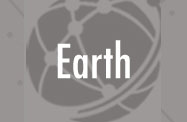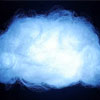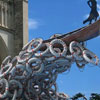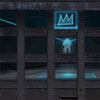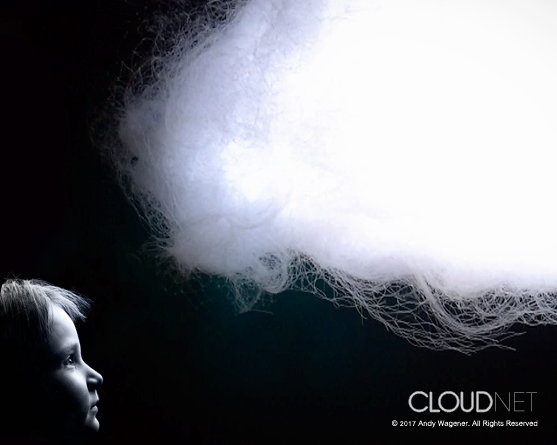
CLOUDNET is an ode to the vast fishing communities that have helped build and sustain Cadiz Bay (Spain) throughout its history. Using a wide variety of netting utilized in fishing, CLOUDNET is activated by the movement of the observer, as pulses of light energize the cloud from within. But this is only dimension of the piece. For it not only shares the stories and hardships of local fishermen today (via recorded interviews), but highlights the devastating phenomenon of ‘ghost fishing’, where lost, dumped or abandoned fishing gear continues to ensnare fish or marine organisms. Beyond the physical interactions with CLOUDNET, the audience is asked to consider both human and marine populations and the possibility and viability of coexistence.

About the Artist
Andy Wagener is an award-winning installation designer, art director and 3D animator. Over the course of his career, he has worked on campaigns for top advertising agencies and collaborated extensively with fine artists, educators and members of the medical community. Andy’s approach is one of visual simplicity, distilling an often complex message or brief down to its essential and most compelling elements. He believes that focused direction coupled with strong design has the ability to communicate universally.
Skills Applied
 MARINE SCIENCE
MARINE SCIENCE
 LIGHTING DESIGN
LIGHTING DESIGN
 ARDUINO/CODING
ARDUINO/CODING
 MODELING AND FABRICATION
MODELING AND FABRICATION
Message From The Artist
“Since I can remember, I’ve always been interested in the history of things. That’s not to say I aced all my history classes. But I was definitely the kid who would (sometimes to the point of annoyance) ask “why?” multiple times in succession. Over time, the question of “why?” was joined by the more exciting question of “why not?”. I asked myself this question a lot when it came to creating things. “Why not make a drawing on this piece of wood or a sculpture out of these discarded plastic lids?” When I became interested in art at an early age, and then activism after that, I began looking for opportunities to create things that prompted others to ask questions. I wanted to start or add to a bigger conversation. So, when I had the opportunity to create work in Cadiz, Spain, this questioning kid went to work. I learned everything I could about the area. Its geography, people, politics and history. As one of the oldest continuously inhabited cities in Western Europe (dating back 3100 years), there was a lot to draw from. Ultimately, I decided to focus on the fishermen there, whose families had been fishing the surrounding waters for generations. In conversations, they told me how things like the transition to the euro, increasing governmental regulations and dwindling fish populations made it increasingly difficult to survive at their trade. As I dug deeper into the decreasing fish populations, I came across the phenomenon of ‘ghost fishing’ – where lost or abandoned fishing gear continues to ensnare fish or marine organisms. The deeper I dug, the more I knew I wanted this to be an important aspect of my work. Combining this potentially deadly gear with these deeply personal interviews, CLOUDNET attempts to highlight the issues faced by both these groups and perhaps leaves participants with some questions of their own..” Andy Wagener
STEMarts Design Tool
The Stemarts Design Tool provides a step-by-step tool to help you come up with a design concept for an installation or sculpture inspired by the work of Paseo artists. Explore the artist’s work and theme to understand what makes it unique. Research the science and technology behind the art to inform your design. Then experiment with the related hands-on activities and tools provided in the STEAM wiki to better understand the artist techniques and process. Finally, Brainstorm with your peers to come up with ideas, and create an Installation Design Concept to share with your school. This tool will take you through each stage of the process. Just click on Explore to get started!
Explore environmental challenges that you are passionate about.
Andy Wagener creates innovative installations that raise awareness to social and environmental challenges. He does this through the use of unique materials and technologies, but also because he chooses topics that he connects with personally. For this activity you will design an installation concept to explore an environmental issue that you are passionate about. For ideas you can visit the United Nations 2030 Sustainable Development Goals. Discuss the issues with your team until you find an environmental challenge that you all agree on.
Research the facts, the materials and the tools.
Once you have identified the environmental challenge, it is time to research the facts about your topic. Check out the STEAM wiki below to get you started. Explore pros and cons, investigate any controversies, and have discussions with experts in the field until you have a strong grasp of the topic. It is also important to start researching materials and tools that can be used to communicate your ideas. Review the artist’s work on this page to learn about how he created the CLOUDNET installation to raise awareness about the dangers of ghost fishing. What can you learn from his process? The research will continue as you progress with the design but you should have enough information to start exploring how to communicate these ideas through art.
Brainstorm and experiment to see what’s possible.
Now that you have done the research on your topic and tools you can start brainstorming on ideas for an art installation and testing out some materials and techniques. Even if you are not going to build the installation in this phase you still need to play around with materials to see what is possible. Explore all the STEAM wikis below which include some fun technology tools that the artist used. Start sketching out concepts and jotting down notes with ideas for an installation. Don’t try to edit at this point. Start a sketchbook just for this project and write or draw anything that comes to mind. This is where you let your imagination run wild!
Get Feedback and iterate.
This is the time to share your concept with peers and experts to get feedback and see how you can improve your design. Practice describing your concept. Discuss and listen to other people’s ideas and remain open to all new possibilities. There will be a lot of trial and error until you arrive at the final design. This stage is especially important to be sure your technical or engineering ideas are feasible. Check our Feedback Tool for some tips.
Create a finished installation design concept.
The next step is to do a final drawing that communicates your design concept for an installation. This could be done by hand or on a computer. The design should show what it will look like and the materials you would use. It would consider possible sites and how people would interact with it. It can include diagrams, text, photos or anything you like. Most importantly it would show how the installation serves to raise awareness to the environmental issue that you chose. Since an installation is multidimensional you will have to find a unique and creative way to communicate your installation concept.
Share your concepts with your classmates and with the visiting artist.
Once all the student drawings are complete they can be displayed in your school. It is fascinating to see the many different ideas and solutions. You can learn a lot by noticing different design approaches and you can share them with the artist when they visit the school. Have fun and don’t forget to share your work with us in the form of photos or videos! We would love to see what you learned.
STEMarts Wiki
activism animation Artist artists awareness biodiversity brainstorming challenge climate change ecosystem services environment environmental art environmental projection art installation fire fishing game ghost fishing ghost net Ghost Nets human impact innovation installation art kinetic art marine science motion ocean ocean plastic oceans Paseo artist plastic project project development recycled plastic robotics sculpture sensors sound sustainable development technology View All waste water

